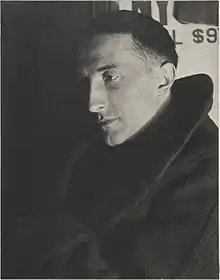Anemic Cinema
Anemic Cinema or Anémic Cinéma (1926) is a Dadaist, surrealist, or experimental film made by Marcel Duchamp. The film depicts whirling animated drawings—which Duchamp called Rotoreliefs—alternated with puns in French. The text, which spirals in a counterclockwise motion suggests a set up of erotic scenarios. Duchamp creates a duality of silence and loudness through images. Duchamp signed the film with his alter ego name of Rrose Sélavy.
Rotoreliefs were a phase of Duchamp's spinning works. To make the optical "play toys" he painted designs on flat cardboard circles and spun them on a phonograph turntable that when spinning the flat disks appeared three-dimensional. He had a printer run off 500 sets of six of the designs and set up a booth at a 1935 Paris inventors' show to sell them. The venture was a financial disaster, but some optical scientists thought they might be of use in restoring three-dimensional sight to people with one eye.[1]
In collaboration with Man Ray and Marc Allégret, Duchamp filmed early versions of the Rotoreliefs and they named the first film version Anémic Cinéma.
The Rotoreliefs are alternated with nine revolving disks with the following text in French, consisting of puns and alliteration by Duchamp:
- "Bains de gros thé pour grains de beauté sans trop de bengué." (Bengay was invented in France by Dr. Jules Bengué)
- "L'enfant qui tète est un souffleur de chair chaude et n'aime pas le chou-fleur de serre-chaude."
- "Si je te donne un sou, me donneras-tu une paire de ciseaux?"
- "On demande des moustiques domestiques (demi-stock) pour la cure d'azote sur la Côte d'Azur."
- "Inceste ou passion de famille, à coups trop tirés."
- "Esquivons les ecchymoses des Esquimaux aux mots exquis."
- "Avez-vous déjà mis la moëlle de l'épée dans le poêle de l'aimée?"
- "Parmi nos articles de quincaillerie paresseuse, nous recommandons le robinet qui s'arrête de couler quand on ne l'écoute pas."
- "L'aspirant habite Javel et moi j'avais l'habite en spirale."
See also
References
- Calvin Tomkins, Duchamp: A Biography (1996), pages 301–303.
